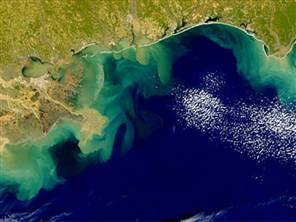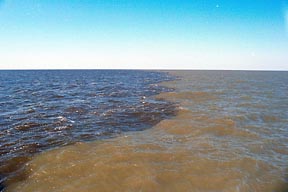


http://www.livescience.com/environment/061019_ap_dead_zones.html, Wikipedia, tttp://daac.gsfc.nasa.gov/CAMPAIGN_DOCS/OCDST/dead_zones.html
Overpopulation puts stress on our environment. It is predicted that the exponential growth of our population will and maybe has exceeded the set limit of our environment. One can see this in many deteriorating ecosystems, such as, the forests, the ozone, the air, and what I will focus on, the oceans. Mankind’s use of the oceans to deposit waste has always come back to hurt us in the long run. Today we are suffering materialistically through a downfall in fishing and intrinsically because of loosing life in areas of the ocean. Dead zones are areas where there is no oxygen at the bottom level of the ocean. Therefore no life is able to live there, creating a dead zone.
It is estimated that there are 200 dead zones in the earth’s oceans. The amount has approximately doubled each decade since the 1960’s. But in the last two years it has risen by more than a third (Life Science). These dead zones usually appear near large populations. The most infamous dead zone currently is the Gulf of Mexico. Stretching 20,000 square miles it is the result of the accumulation of run-off from 40 states into the Mississippi River. In the spring melting snow and rainfall create river flooding and carry agricultural fertilizers and municipal sewage into the Mississippi River and out into the Gulf of Mexico. The fresh water, nitrogen, and phosphorus form a layer on top of the denser salt water in the Gulf. When the sun hits the pollution in this top layer blooms of algae and phytoplankton are created. The nitrogen and phosphorus that helps plants grow on land also makes them grow in water. As the algae and phytoplankton inevitably die and decay at the bottom of the ocean they consume the dissolved oxygen there. Eventually all the oxygen in the saltier water is used requiring the addition of new oxygen from the surface. But new oxygen is unable to get through the top layer of fresh water that is blocking the salt water from the surface. "The effect can be akin to taking Saran Wrap and placing it over (an area the size of) Connecticut and Rhode Island, slowly pulling it down and suffocating everything beneath it," said Melissa Samet, a lawyer and wildlife biologist with the Sierra Club Legal Defense Fund. By midsummer all the oxygen in a large area of the Gulf could be gone and thus creating a dead zone (Pulitzer).
Another cause of dead zones is appearing to be global warming. On the coast of Oregon a 70-mile long hypoxia zone first appeared in 2002 and has increased in detriment since. Instead of the booms of phytoplankton being from fertilizers it is from upwelling. The upwelling occurs when northerly winds blow the surface waters offshore. Deeper, colder, and more nutrient water replaces it at the surface. In the summer the sun causes a growth in phytoplankton, which eventually die and consume the oxygen at the bottom of the ocean. As upwelling continues the layer of low oxygen water becomes thicker and lower in oxygen. Dead zones caused by upwelling occur in shallow areas, around 50 feet, because new upwelling carry low oxygen water to shore. Other dead zones like this are off the coast of Namibia, South Africa, and Peru (Life Science). "We know it's not pollution. It's not a toxic algal bloom. The simple fact is there's not enough oxygen,'' said Francis Chan, a research professor of zoology at Oregon State who has been measuring the oxygen levels.
The animals most affected by dead zones are those that live on and in the sand, such as, clams, crabs, and worms. They are unable to move fast enough to find oxygen, like fish and mammals are. But it affects the food chain from the bottom up. Without the usual animals to eat on the bottom of the ocean fish and sting rays swim to the surface or new areas where they are easy prey (Earth Policy).
There seems to be a direct correlation between population growth and the growth of dead zones. Two examples show this, first the increase in food production as a result of population growth and second the decrease in wetlands as a result of population growth. With the increase in population food production also needs to increase, and with that comes the use of more pesticides and fertilizers. The pesticides and fertilizers end up in the ocean creating and adding to dead zones. Population growth also requires additional land. Wetlands, which filter nutrients, are filled for development. Half of the wetlands in the world have been lost because of development. "No other parameter of such ecological importance has been changed so drastically in such a short period of time by human activities as dissolved oxygen contents in the world’s oceans," said Robert J. Diaz, a researcher at the Virginia Institute of Marine Sciences and president of the Atlantic Estuarine Research Society.
Dead zones have a detrimental affect on the fishing industry. In the Gulf of Mexico 18 percent of the U.S. annual catch is disrupted because of the dead zone. In Oregon and Washington dead crabs turn up in crab pots, deep-water fish migrate to the shore for oxygen affecting fishermen’s catch. In 1986 the Norway lobster industry collapsed because of the dead zone Kattegat straight (Earth Policy). Possible solutions for the growth of dead zones is efficiency improvements, renewable energy, a better buffer between fields and streams that will filter run-off, more wetlands, improvement in sanitary codes, and restrictions on fertilizers and pesticides. There is a lot we can do to protect the oceans from dead zones, we just have to start changing the way we live. The government needs to enforce legislation to cut back on fertilizers and greenhouse gasses. The population and economic growth needs to level out. “If we continue like we are now, we could see some ecological shifts,'' Jack Barth, professor of oceanography at Oregon State said. "It all depends on what happens with the warming and the greenhouse gases.''